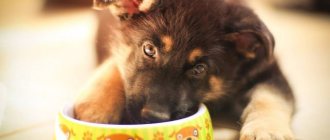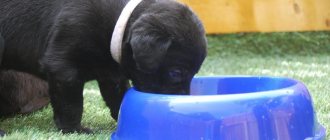Around three to four weeks of age, the mother dog will no longer feed her puppies as often as before. The mother will gradually reduce her milk supply and encourage her puppies to try easy-to-chew wet foods.
Weaning puppies should not begin too early because puppies will not yet be able to chew and digest solid food on their own. If a dog stops feeding her puppies too early, you will need to step in and help care for the entire litter. The feeding period lasts from 3 to 5 weeks, as does the weaning process.
Selecting food for the baby
The best option is to find a female dog with puppies of approximately the same age. While you are searching, purchase a special mixture from a veterinary pharmacy or pet store - a substitute for bitch milk and dilute it according to the instructions. If you need to feed the babies urgently, then give boiled water with glucose - 3.5 ml per 100 g. body weight.
Regular cow's milk is not suitable for puppies in terms of fat content. Its composition is far from the composition of dog milk.
In the absence of suitable food for your ward, temporarily use recipes for a “homemade” mixture:
- two eggs are mixed with half a liter of whole cow's milk, give this mixture heated;
- beat one egg in 100 ml of cow's milk and add a drop of vitamins A and D, heat in a steam bath before use;
- 1 tsp pour honey with half a glass of heated boiled water.
It wouldn’t hurt to consult a veterinarian about what to feed puppies that have lost their mother’s milk. In this case, you need to take into account the breed of the animal - how large the dog is.
When to offer puppies a saucer
It depends on the specific situation. There are objective reasons why you need to supplement earlier. If the mother's milk supply is low or the litter is very large, goat's milk is the best choice. It is advisable to use raw, whole. You can add one yolk to a glass of milk. Before reaching four weeks of age, it is best to use quail eggs, and then add chicken eggs.
It makes sense to start feeding puppies at 14 days of age if weight gain has slowed down. If they continue to recover well, you can defer the introduction of additional feeds for another week. Or you can wait another week and start weaning on solid food from four weeks of age.
Preparing for feeding
Before feeding, your puppy's temperature should be measured. If the temperature drops to 35.5 degrees, the baby is pre-warmed. Otherwise, his gastrointestinal tract will not cope with the load. The easiest way is to warm up under a jacket with the heat of your own body, but this process can take up to three hours. While the puppy is warming up, if necessary, he is given a glucose solution.
Another important procedure before eating is massage. Mom licks her offspring, massaging their tummies and starting their work. Take damp cotton wool and wipe the baby - girls around the navel and genitals, and males - in the direction from the navel to the penis. In the absence of massage, the patient faces stomach problems.
A few more rules:
- the prepared mixture is not stored, it is diluted anew each time;
- before feeding, wash your hands with soap and boil the bottle for 5-15 minutes;
- check the temperature of the mixture by dripping on your wrist - it should be 38-40 degrees.
How much food does a puppy need?
For medium and large breed puppies, there is a clear formula: they need 5 to 8% of their body weight. Moreover, this portion is adjusted once a week. But the main guideline remains the condition of the puppy. He shouldn't get fat or look thin. You can focus on the ribs. They should not bulge, but upon palpation they can be easily felt. If the puppy is cheerful, runs around a lot and is interested in the world around him, he will definitely have a good appetite. At the same time, it is necessary to provide him with high-quality food, complete sources of all necessary nutrients.
How to feed a puppy
To feed your baby you will need a bottle - a special one from a pet store or a regular baby bottle. Puppies of small dog breeds are fed with a syringe or pipette; if the dog is large, then a pacifier is used. Using a heated needle, a hole is punched on the nipple - neither large nor small. The mixture should not flow in a stream, and the puppy should not use excessive force to suck the food. If the baby does not have bubbles from the nose when feeding, the hole is of a suitable size. If you punched a hole that was too big, let your baby catch his breath before continuing to feed.
Do not try to feed your ward as quickly as possible - there is a danger of choking. If the baby himself wants to suck everything out as quickly as possible, force breaks.
If the puppy pushes the pacifier away, use a trick. Moisten it with milk and drop it on the animal's tongue. Then he will understand that this is food. If your child persistently pushes the bottle away with his paws, then hold them with one hand or swaddle the baby.
When giving your baby formula, hold the bottle at a 45-degree angle. The optimal position for feeding is as close to natural as possible:
- turn your stomach down;
- lay on your knees;
- raise your head.
When the baby is full, he will turn away from the pacifier himself. Hold it upright for a couple of minutes to allow excess air to escape. After eating, massage will be required again to ensure that the puppy goes to the toilet well. Take a damp cloth soaked in warm water and massage your tummy in a circular motion. After the massage, the baby will want to fall asleep - this is normal. For the first few days they eat and sleep.
A puppy's belly that is too bloated after eating indicates overeating. Experts say that it is better to underfeed than to overfeed.
Large breed dogs
The most popular can be considered the German Shepherd. Complementary feeding of shepherd puppies begins from 18-20 days of life. These puppies are quite large and require a lot of calcium and nutrients to grow and develop. From this time on, calcined cottage cheese can be introduced. It performed very well in the combination “cottage cheese - milk - raw egg” or “cottage cheese - egg - carrot juice”. From day 22 you can add lean beef. To do this, it is scraped or ground in a blender. A good option would be a mixture of milk, cottage cheese and minced meat.
From about 26 days of life, milk porridge can be introduced into the diet. Cereals must be ground in a coffee grinder. Start with one cereal, and when your baby’s stomach gets used to it, you can add the next one.
Feeding volumes and schedule
Newborn puppies need about 30 ml of mixture per day. In the very first feedings, it is enough to give 1 ml at a time. From the second week, increase the volume to 4-10 ml per feeding. If you feed correctly and the baby eats enough, he sleeps peacefully between feedings. An undernourished baby behaves restlessly. For reference, a puppy weighing 300 grams eats two full pipettes. If the baby grows and becomes round, he has enough food.
The older the baby, the less often he needs food. In the first days, the mixture is given approximately every two hours - 10 times a day. In the second or third week of life, reduce the number of feedings to 6-8 times and eliminate nighttime snacks. Month-old puppies are fed 5-6 times a day.
The frequency of meals depends on the strength of the baby. If he was born premature and weak, then at first he will have to feed every 1.5-2 hours.
You need to transition to solid food gradually. Start when the baby opens his eyes - in about two weeks. Teach him to lap up the mixture from a saucer, offer cottage cheese from baby food. Give less formula and more solid food. On the 18th day, you can give dry food soaked in warm water if you plan to feed it in the future. Start with a mini portion on your fingertip.
Period from birth to three weeks.
One should not think that puppies, while they are blind, are meaningless toys. A newborn puppy, as soon as he has taken a breath of air and adjusted his breathing, moves independently and finds the nipple. Even being blind and deaf, they can smell and feel warmth. Of course, during this period they are completely dependent on their mother - a source of warmth and food.
Puppies should approximately double their weight in the first week of life. Already on the second day after birth, the puppy becomes dense and elastic to the touch, its coat is smooth and clean. He sucks, pulling back the nipple and pressing his paws on the mammary gland. Puppies actively seek out nipples and may push each other away. By the end of the first week of life, the puppies weigh approximately the same; but, if there is a small and weak puppy in the litter, you need to make sure that it is not pushed away by stronger ones, and always put it close to the nipples. A puppy that doesn't suckle likely won't survive, no matter how hard you try to feed it. Often the mother dog itself pushes away weak and non-viable puppies. For the first two weeks, the mother takes full care of the puppies; you just need to make sure that she doesn’t accidentally run over them and that she has enough food herself. The dog cleans the nest itself by eating the puppies' excretions. It is necessary to periodically change the litter so that it is always clean. The room where the puppies are kept should have a constant temperature (about 23 °C) and no drafts. Starting from the seventh day, the temperature can be lowered slightly. If the mother dog is not constantly in the nest, the puppies can be placed on an electric heating pad or warmed with an infrared lamp. At 12-14 days, puppies begin to see and hear. They are already growing baby teeth. By this time, puppies of some breeds are already standing on their paws and trying to walk (puppies of heavy dog breeds - bloodhounds, mastiffs - begin to walk later). By this time, it would be good to make a special enclosure for the puppies so that they do not wander around the entire apartment. As soon as the puppies begin to move independently, they crawl out of the nest to empty their bowels. Therefore, you can put a soft faux fur bedding in the nest (the puppies won’t get it dirty). The floor in the enclosure is usually covered with newspapers, which makes puddles and piles easier to clean up. A puppy accustomed to newspapers will be easier to train to go to the toilet in a certain place. The floor, of course, must be waterproof (for example, linoleum); it must be wiped with some kind of disinfectant solution once every two days. As soon as the puppies open their eyes and their teeth appear (14-15 days), they can begin to be fed. Now you can buy special porridge for puppies at the pet store. If puppies are weak or their digestion is often upset, it is better to start complementary feeding with a special porridge. Strong, robust puppies can be given meat. Usually they make a “scraper”: frozen meat is thinly sliced, then separated into fibers, defrosted and rolled into balls approximately the size of a pea. Each ball is lightly moistened with vegetable oil and placed in the puppy’s mouth. If the puppies feel well after the first feeding, they can be fed meat first once and then twice a day. In addition to meat, puppies are fed calcined cottage cheese, which is made from milk: add 3-4 tablespoons of calcium chloride to 1 liter of milk and heat the mixture until the milk curdles. Then the whey is drained (it can be given to the dog), the cottage cheese is mixed with milk and given to the puppies. Food for small puppies should be heated to approximately 35 5C: food that is too cold can cause stomach upset, and food that is too hot will burn the mucous membrane of the mouth and esophagus. Puppies can be given various milk porridges (for example, from rolled oats or wheat flakes), but it is better to feed them with ready-made food for puppies (Ekanuba Pappy, Pedigree Advance Junior-1 and others). The food is soaked overnight in boiled water, broth or milk, it swells and is given to the puppies in this form. Ready-made food contains much more nutrients than regular cereals and is rich in all essential vitamins and minerals. Puppies, especially large breeds, will have a more marketable appearance by two months if they are fed with ready-made food. From the very beginning, puppies should be taught to eat from a bowl, and not from a nipple. The first portions of new food are placed directly into the puppies' mouths. Okies very quickly understand what is required of them and begin to eat. Small puppies are not given separate bowls - all the puppies will climb into one of them anyway. Typically, for a litter of seven puppies, three large deep plates or low bowls with heavy bottoms are placed (so that the puppies cannot tip them over). The puppies will run from one bowl to another, getting into them whole, but in the end they will all eat. Ready-made food is given to puppies according to the instructions (a certain amount of food per kilogram of weight of the puppy), so much porridge should be given so that after feeding some of it remains in the bowls.
From three weeks to two months.
By three weeks of age, puppies can be fed two to three times a day. At the age of three weeks to two months, puppies should be gradually weaned from suckling their mother and transferred to regular food. Puppies should always have access to clean drinking water. Despite the fact that puppies receive protection from infections from their mother's colostrum, during this period of their life the risk of disease is quite high. First of all, infection with worms is dangerous. The first time an anthelmintic is given at the age of 21 days (it is better to give special veterinary drugs intended for puppies). If you suspect that the anthelmintic medicine has not worked, you can take the puppies' feces to a veterinary laboratory for parasitological testing. If you are infected with fleas, you can; Use only special medications intended for puppies. * Symptoms and treatment of infectious diseases - colibacillosis, salmonellosis, viral infections were described in the section “When a dog gets sick”. Most mother dogs take good care of their puppies by licking them, and you don't need to help her do this. However, some dogs place the responsibility of caring for their puppies on their owner. In this case, you will need to make sure that the puppies are clean, wipe the anus, ears and eyes with a clean napkin. At this age, puppies need to have their nails trimmed weekly to prevent them from damaging the mother's mammary glands. The older the puppies get, the more often their mother leaves them. During the period of weaning from mother's milk, you need to prepare a place for the dog that would be inaccessible to puppies and where she could rest from her “little tormentors.” The number of milk feedings (when puppies suckle from their mother) should be gradually reduced, starting at 3-4 weeks of age. By the age of two months, puppies should already be fully fed with food and not suckle from their mother. By this age, the bitch’s milk disappears. At the age of 40 days, purebred puppies are usually examined by a specialist from the kennel club and, if the puppies meet the standard, they are issued with the documents necessary for sale (puppy card). This procedure is called activation. By this point, the puppies must have gained a certain weight (for example, a German Shepherd puppy must weigh at least 4 kg, a collie puppy - at least three)
What problems can arise with breastfeeding - and why?
Breastfeeding doesn't always go smoothly. If the function of the mammary glands is impaired, when breast milk is produced less or more than normal, animals cannot do without human help.
Little or no milk
Hypogalactia and agalactia are pathological disorders characterized by partial or complete absence of milk. They arise for the following reasons:
Diseases of the reproductive system
(vaginitis, endometritis, ovarian cysts), accompanied by inflammatory processes and hormonal imbalances.
Poor living conditions
. The risk group includes animals kept in cold and damp rooms.
First birth and severe stress
. In young bitches, milk production has not yet been regulated, so both phenomena are completely normal for her. Also, a malfunction of the glands can be explained by anxiety due to previously unfamiliar sensations.
Poor nutrition.
An unbalanced natural diet and feeding with economy-class dry granules are fraught with vitamin deficiency. Due to the lack of vitamins, there are simply no resources left for milk production.
Difficult birth.
The problem often occurs with heavy blood loss and caesarean section.
Taking certain medications.
During pregnancy, the range of acceptable medications is very limited, so drug treatment should only be carried out under the supervision of a veterinarian.
Hypogalactia and agalactia are easily detected by the behavior of puppies. Healthy and well-fed newborns are very calm and sleep a lot, huddled next to the mother's belly. When there is a lack of food, they squeak loudly, fuss and actively crawl around the “nest” in search of other food sources. Hungry babies do not gain weight and lose weight quickly.
If the bitch does not have milk, then she can leave the “nest” for a long time, prevent the puppies from feeding and even attack them. All these actions are explained by the severe pain caused by the cubs while sucking on an empty breast.
When to stop lactation
Feeding too much is no less dangerous, as it increases milk production. Excess fluid gradually accumulates in the breast and provokes the development of mastitis. In this case, production is stopped artificially, without waiting for the end of the lactation period.
In addition to the example discussed, the owner’s help is required when symptoms of false pregnancy appear, the death of newborns or early weaning from the mother.
Artificial and fed puppies
Do not confuse babies who started complementary feeding early with artificial puppies who received very little or no mother’s milk. At the age of 2 months, they will always look smaller than their two-month-old peers, and have a slightly lower weight. As a rule, with proper care and proper selection of diet, by 4-6 months the artificial ones successfully catch up with their brothers.
Shepherd dogs raised on proper complementary feeding, if they reach a minimum weight of 8 kg (boys) and 7 kg (girls), can be given to new owners from 8 weeks, that is, at 2 months.
By this time, the patronized shepherd dog should look dense and strong: the back should not be sagging and the belly should not be swollen.
The new owner will then take care of the baby and calculate the diet of the growing German Shepherd.
The need to introduce complementary feeding to puppies at different ages
Before we figure out when to feed puppies, let's look at the need to introduce new foods. It depends on the age of the animal.
Up to 1 month
Newborns are raised by their mother. Until 1 month, she takes on all feeding concerns. Outside help is required only if there is a shortage of milk, a categorical refusal to feed one's own cubs, or the death of a dog.
Ready-made milk formulas are sold in veterinary pharmacies and pet stores. Their composition is as close as possible to the original.
Artificial feeding with cow's or goat's milk is only permissible as an emergency option for a couple of days, since these products do not contain the necessary vitamins.
INTERESTING!
In addition to the composition, fat content is important. In dog milk it reaches 9.5%, and in cow and goat milk - 3.3% and 3.8%, respectively.
After 1 month
On average, breastfeeding lasts up to 2-2.5 months. Despite this, it is gradually losing its benefits. The amount of milk is also reduced. Because of this, babies may be stunted. At this stage, complementary foods come to the rescue.
Grown-up cubs begin to become interested in the food in their mother's bowl, but not all adult food suits them. For this reason, the owner should be responsible for preparing the diet and feeding regimen.
How to tell if your dog has enough food
Dogs love to eat, eat quickly and get full slowly. Normally, the pet should quickly eat what is offered, lick the bowl and, looking a little offended at the owner, calmly go back to his place. If he leaves food in the bowl and refuses additional treats between meals, then the portion can be reduced.
When the pet begins to inspect the feeding area with a hungry look, look into the owner’s eyes, and rattle bowls in the kitchen at night: the portion should be increased.
It is possible to determine whether your four-legged friend is well-fed by palpating his ribs in a sitting position. Normally, they are palpable and do not stick out or hide under a layer of fat.
The puppy should not be fed at the same time as its owners. Food means a lot in an animal's life. The owner must be an authority, a leader, and the leader, as a rule, dines first. With regular feeding during family meals, the dog is subsequently able to take food from the hands of diners. It happened that animals snatched food from children: these were the ones to whom the owners threw pieces from the table. A dog is known to protect its food during a meal: it growls, driving everyone away. Therefore, you should feed your four-legged friend after the whole family has eaten and keep children away from her at this time. Raise your puppy, feed him correctly, and then he will delight you with health, cheerfulness and well-mannered behavior.
Dog diseases and milk
Dog owners often think that foods that are healthy for humans will benefit their pet - this is a misconception. For example, milk is used to treat colds in people, but if a dog is sick, this method of treatment may not only not help, but also harm.
Often, animals are given milk when they are poisoned, in the belief that it will help neutralize toxins. Indeed, this is possible if lead, mercury or other heavy metal salts enter the body. This is a rare case. In other cases of intoxication, milk will not only not help, but will also worsen the situation.
In case of poisoning, dogs are given light food that is easily digested and does not overload the gastrointestinal tract.
Sometimes with diarrhea and vomiting, breeders try to help the pet by feeding it milk. This only worsens the situation; enteritis requires a large amount of fluid and properly selected medications, which can only be prescribed by a veterinarian. Self-medication is never beneficial.
If dogs without allergic reactions regularly eat dairy products, other unpleasant consequences may occur. For example, urolithiasis. It develops against the background of a high concentration of calcium, which forms stones of various shapes and sizes. It is these diseases that are difficult to treat and can be fatal for the animal. Dairy products are especially dangerous for a number of breeds predisposed to KSD. These are dwarf poodles, Yorkies, Shih Tzus, and Bichon Frizes.
If we talk about the benefits and harms of milk for dogs, then during the period of illness it is an undesirable product, and during the lactation period in a lactating bitch it is recommended.
Regardless of whether a dog drinks milk just like that or as directed, it is necessary to carefully monitor its health. If there is the slightest disturbance in the gastrointestinal tract or allergic disorders, the product should be excluded and consult a doctor.
How many times a day should you feed an adult dog?
The dog's physical maturation is completed by the age of one year. After this period, the owner can safely switch the pet to two or even one meal a day. This approach contributes to the active development of the pet and fully satisfies its needs.
A dog is a member of the family. But she shouldn’t be treated like a capricious child. You should not feed your pet on a variable schedule - this is guaranteed to lead to the development of many troubles, including overeating, weight gain, and the development of chronic diseases. Eating food should occur strictly at the same time.
Eating on a schedule allows you to accurately track the number of calories your dog has consumed.
Separate food
A prerequisite is separate feeding. There is no need to create a vinaigrette by trying to feed meat, eggs, and soaked food in a small portion at the same time.
Cottage cheese and porridge must be present in the puppy's complementary foods
The stomach of a small puppy is not capable of producing many digestive enzymes, and each type of food requires its own composition of gastric juice.
The imperfection of the stomach of a one-month-old shepherd dog does not allow it to tune in to produce the necessary enzyme if the food has a multi-species composition. Such food lies in a lump at the bottom of the stomach and lingers there for a long time.
The result is vomiting or diarrhea, when the lump nevertheless pushes into the intestines. There will be no benefit from such complementary foods, but indigestion or persistent refusal to eat is easy.
This does not happen when different types of food are taken separately, because the ventricle is able to cope separately with porridge, separately with meat, separately with cottage cheese.
Which dog food to choose
Dog owners are constantly arguing about what type of feeding is best for their pets. Some owners are sure that this is special food for dogs, while others prefer a homemade diet prepared with their own hands. Who is right?
Benefits of dry food:
- immediately ready to eat;
- balanced, contains vitamins, minerals, micro and macronutrients;
- safe for health, as it is produced with the support of veterinary laboratories;
- easy to dose (a huge plus for pets prone to obesity);
- long shelf life;
- simple storage conditions;
- variety of tastes;
- the ability to choose a diet according to the owner’s budget.
Flaws:
- not all food is healthy (especially cheap products);
- there is a risk of developing an allergic reaction;
- Some pets eat food reluctantly or refuse it altogether.
Natural benefits:
- the owner himself controls the pet’s diet;
- the dog consumes natural products that have not been industrially processed;
- Animals eat natural food better.
Flaws:
- difficulty in calculating daily caloric intake, maintaining the balance of fats, proteins, carbohydrates;
- difficult to store food (meat, perishable ingredients);
- increased risk of parasite infection through raw meat, fish and offal;
- the need to find a source of dietary fiber - not all dogs agree to eat greens, vegetables and fruits.
Choosing a diet for a pet is not an easy task. The owner should focus not only on his preferences, but also on the characteristics of the dog’s breed.
If the owner has the opportunity to purchase a variety of meat and wisely combine it with vegetables, fruits, and cereals, then natural feeding will only benefit the furry friend. However, you shouldn’t give up on dry food. Many brands produce products that are not inferior in quality to natural food. This fact is confirmed by numerous laboratory studies.
Types of milk in dog nutrition
It turns out that the animal’s reaction depends on the type of milk. A cow, goat and horse have completely different compositions of nutrient fluid, and accordingly, their effect on the body. For dogs, as for people, it is recommended to choose a drink based on its benefits and ease of digestion.
Goat
The best product for feeding newborns and animals. Despite the somewhat specific taste and aroma, the product is extremely useful and is not inferior in properties to the mother’s. The maximum concentration of vitamins and microelements is perfectly absorbed and lays the foundation for the immune system. The amount of allergen is minimal, so negative perception of the product is reduced to zero. Despite this, milk is first given diluted to drink, then they begin to cook porridge with it, and only after that they are allowed to drink it in its pure form.
Cow
The most common type of product, widely used for feeding puppies. It contains a lot of lactose, but if there is no reaction, the animal can be fed cereals with milk for up to a year, gradually reducing its amount. Kefir and cottage cheese can be left in the animal’s diet forever, if the products are well tolerated.
Kobylye
The product is radically different from the above in composition. It is low in protein and fat, and lactose is present in excess. Veterinarians are categorically against the use of this product for feeding dogs. Kumis is made from milk; it is contraindicated for animals and children due to the presence of alcohols in the composition.
What else do you need to know about feeding puppies?
The topic of feeding a puppy is inexhaustible. Scientists are constantly making various discoveries in this area, trying to protect our furry pets. Feeding a puppy should be approached responsibly, since at an early age the foundation of the dog’s health is laid.
It is very important to give breastfed babies various vitamins and microelements as a nutritional supplement. After all, products cannot fully meet all standards. But for puppies receiving dry food, such an additive will be unnecessary and even dangerous.
Important! In the autumn-winter period, puppies should be given fish oil with vitamins A and D for proper bone formation and the prevention of rickets.
And finally, the question that concerns many people is the need to add salt to puppies’ food. Here you should rely more on your intuition, and not on the advice of “experienced” people. The best option would be to add a pinch of salt once a day to some dish, for example, porridge. But it’s definitely not a good idea to salt your dog’s food as if it were your own, just as you shouldn’t completely deprive your pet of table salt. All living beings need it in small quantities for water-salt balance.
Cases of lactose intolerance in dogs
Lactose intolerance is legendary; a high percentage of the world's population suffers from this type of allergy. Animals are no exception. Given the increase in negative reactions to the component, various conclusions are drawn. Some biologists suggest that the cause is a deteriorating environmental situation, others blame the antibiotics that are fed to animals and people.
Negative reactions to lactose in dogs are known and, unfortunately, they are not uncommon. Therefore, dairy should be introduced into your pet’s diet with extreme caution, just like for infants. Cook liquid porridge, preferably oatmeal or semolina, in milk and water in a 1:1 ratio and give it a little at a time, observing the animal’s reaction.
Manifestations of allergies can be different. Some dogs immediately experience bloating and intestinal upset, while others experience vomiting or other combined symptoms. Regardless of the reaction, you should consult a doctor to confirm the fact of intolerance to the component.
Sometimes skin itching and redness are signs of a lactose allergy. Some owners mistake this for seasonal shedding or a reaction to detergents. If any strange symptoms appear in your dog while introducing dairy products into the diet, you should contact your veterinarian.











